University of Suffolk Business Decision Making Essay Analysis
VerifiedAdded on 2023/01/13
|7
|1409
|63
Essay
AI Summary
This essay provides a comprehensive analysis of business decision-making processes, specifically focusing on investment appraisal techniques. The core of the essay revolves around a case study of ABC plc, a UK-based software company, and its decision to invest in a new business venture. The analysis employs two key methods: Net Present Value (NPV) and payback period. The essay meticulously calculates these metrics for two hypothetical projects (Project A and Project B), demonstrating how managers can use these tools to assess the viability of potential investments. The results of the calculations are then thoroughly analyzed, highlighting the benefits and drawbacks of each method. In addition to the quantitative analysis, the essay also considers the influence of both financial (e.g., return on investment, interest rates) and non-financial factors (e.g., management, competitors, business environment) on the decision-making process. Practical implications of the analysis are discussed, emphasizing the importance of considering multiple factors when making investment choices. The essay concludes by reiterating the significance of sound decision-making processes and the value of employing various analytical tools to mitigate risks and maximize returns. The essay is supported by references to relevant academic literature.

Essay on Business
Decision Making
Decision Making
Paraphrase This Document
Need a fresh take? Get an instant paraphrase of this document with our AI Paraphraser

Table of Contents
INTRODUCTION...........................................................................................................................3
MAIN BODY...................................................................................................................................3
Calculation of Payback Period.....................................................................................................3
Calculation of Net Present Value (NPV).....................................................................................4
Analysis........................................................................................................................................4
Practical Implications...................................................................................................................5
CONCLUSION................................................................................................................................6
REFERENCES ...............................................................................................................................7
INTRODUCTION...........................................................................................................................3
MAIN BODY...................................................................................................................................3
Calculation of Payback Period.....................................................................................................3
Calculation of Net Present Value (NPV).....................................................................................4
Analysis........................................................................................................................................4
Practical Implications...................................................................................................................5
CONCLUSION................................................................................................................................6
REFERENCES ...............................................................................................................................7
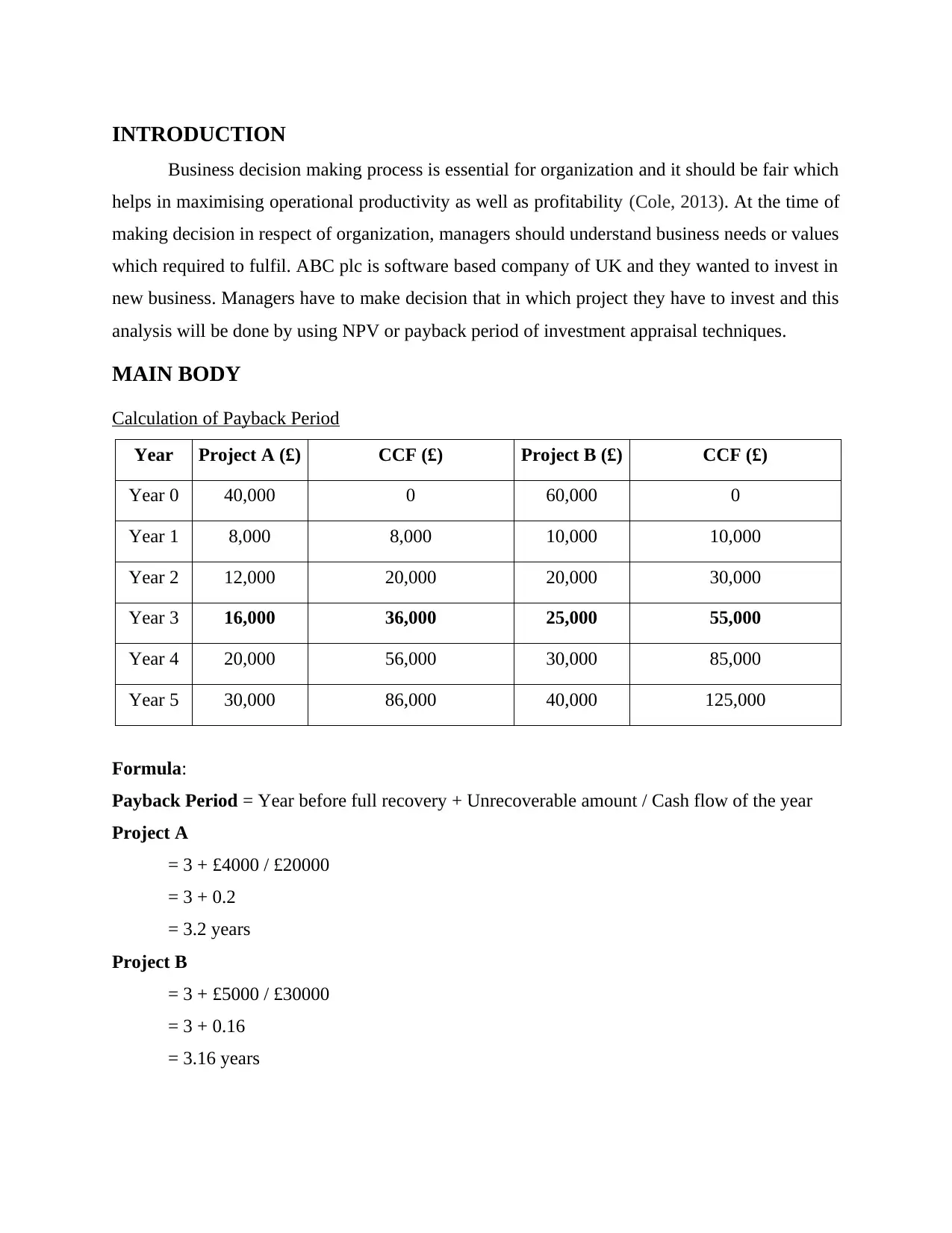
INTRODUCTION
Business decision making process is essential for organization and it should be fair which
helps in maximising operational productivity as well as profitability (Cole, 2013). At the time of
making decision in respect of organization, managers should understand business needs or values
which required to fulfil. ABC plc is software based company of UK and they wanted to invest in
new business. Managers have to make decision that in which project they have to invest and this
analysis will be done by using NPV or payback period of investment appraisal techniques.
MAIN BODY
Calculation of Payback Period
Year Project A (£) CCF (£) Project B (£) CCF (£)
Year 0 40,000 0 60,000 0
Year 1 8,000 8,000 10,000 10,000
Year 2 12,000 20,000 20,000 30,000
Year 3 16,000 36,000 25,000 55,000
Year 4 20,000 56,000 30,000 85,000
Year 5 30,000 86,000 40,000 125,000
Formula:
Payback Period = Year before full recovery + Unrecoverable amount / Cash flow of the year
Project A
= 3 + £4000 / £20000
= 3 + 0.2
= 3.2 years
Project B
= 3 + £5000 / £30000
= 3 + 0.16
= 3.16 years
Business decision making process is essential for organization and it should be fair which
helps in maximising operational productivity as well as profitability (Cole, 2013). At the time of
making decision in respect of organization, managers should understand business needs or values
which required to fulfil. ABC plc is software based company of UK and they wanted to invest in
new business. Managers have to make decision that in which project they have to invest and this
analysis will be done by using NPV or payback period of investment appraisal techniques.
MAIN BODY
Calculation of Payback Period
Year Project A (£) CCF (£) Project B (£) CCF (£)
Year 0 40,000 0 60,000 0
Year 1 8,000 8,000 10,000 10,000
Year 2 12,000 20,000 20,000 30,000
Year 3 16,000 36,000 25,000 55,000
Year 4 20,000 56,000 30,000 85,000
Year 5 30,000 86,000 40,000 125,000
Formula:
Payback Period = Year before full recovery + Unrecoverable amount / Cash flow of the year
Project A
= 3 + £4000 / £20000
= 3 + 0.2
= 3.2 years
Project B
= 3 + £5000 / £30000
= 3 + 0.16
= 3.16 years
⊘ This is a preview!⊘
Do you want full access?
Subscribe today to unlock all pages.

Trusted by 1+ million students worldwide
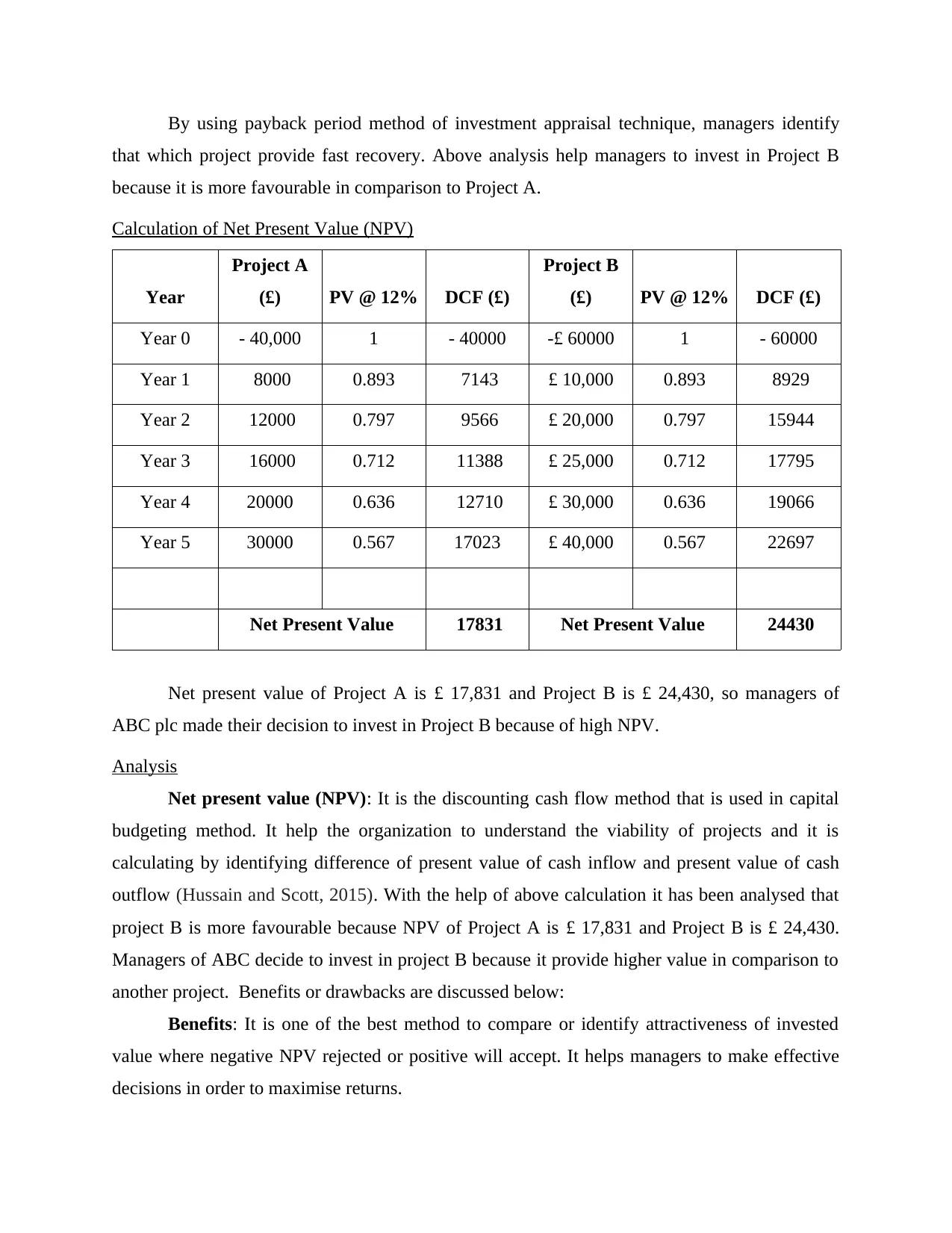
By using payback period method of investment appraisal technique, managers identify
that which project provide fast recovery. Above analysis help managers to invest in Project B
because it is more favourable in comparison to Project A.
Calculation of Net Present Value (NPV)
Year
Project A
(£) PV @ 12% DCF (£)
Project B
(£) PV @ 12% DCF (£)
Year 0 - 40,000 1 - 40000 -£ 60000 1 - 60000
Year 1 8000 0.893 7143 £ 10,000 0.893 8929
Year 2 12000 0.797 9566 £ 20,000 0.797 15944
Year 3 16000 0.712 11388 £ 25,000 0.712 17795
Year 4 20000 0.636 12710 £ 30,000 0.636 19066
Year 5 30000 0.567 17023 £ 40,000 0.567 22697
Net Present Value 17831 Net Present Value 24430
Net present value of Project A is £ 17,831 and Project B is £ 24,430, so managers of
ABC plc made their decision to invest in Project B because of high NPV.
Analysis
Net present value (NPV): It is the discounting cash flow method that is used in capital
budgeting method. It help the organization to understand the viability of projects and it is
calculating by identifying difference of present value of cash inflow and present value of cash
outflow (Hussain and Scott, 2015). With the help of above calculation it has been analysed that
project B is more favourable because NPV of Project A is £ 17,831 and Project B is £ 24,430.
Managers of ABC decide to invest in project B because it provide higher value in comparison to
another project. Benefits or drawbacks are discussed below:
Benefits: It is one of the best method to compare or identify attractiveness of invested
value where negative NPV rejected or positive will accept. It helps managers to make effective
decisions in order to maximise returns.
that which project provide fast recovery. Above analysis help managers to invest in Project B
because it is more favourable in comparison to Project A.
Calculation of Net Present Value (NPV)
Year
Project A
(£) PV @ 12% DCF (£)
Project B
(£) PV @ 12% DCF (£)
Year 0 - 40,000 1 - 40000 -£ 60000 1 - 60000
Year 1 8000 0.893 7143 £ 10,000 0.893 8929
Year 2 12000 0.797 9566 £ 20,000 0.797 15944
Year 3 16000 0.712 11388 £ 25,000 0.712 17795
Year 4 20000 0.636 12710 £ 30,000 0.636 19066
Year 5 30000 0.567 17023 £ 40,000 0.567 22697
Net Present Value 17831 Net Present Value 24430
Net present value of Project A is £ 17,831 and Project B is £ 24,430, so managers of
ABC plc made their decision to invest in Project B because of high NPV.
Analysis
Net present value (NPV): It is the discounting cash flow method that is used in capital
budgeting method. It help the organization to understand the viability of projects and it is
calculating by identifying difference of present value of cash inflow and present value of cash
outflow (Hussain and Scott, 2015). With the help of above calculation it has been analysed that
project B is more favourable because NPV of Project A is £ 17,831 and Project B is £ 24,430.
Managers of ABC decide to invest in project B because it provide higher value in comparison to
another project. Benefits or drawbacks are discussed below:
Benefits: It is one of the best method to compare or identify attractiveness of invested
value where negative NPV rejected or positive will accept. It helps managers to make effective
decisions in order to maximise returns.
Paraphrase This Document
Need a fresh take? Get an instant paraphrase of this document with our AI Paraphraser
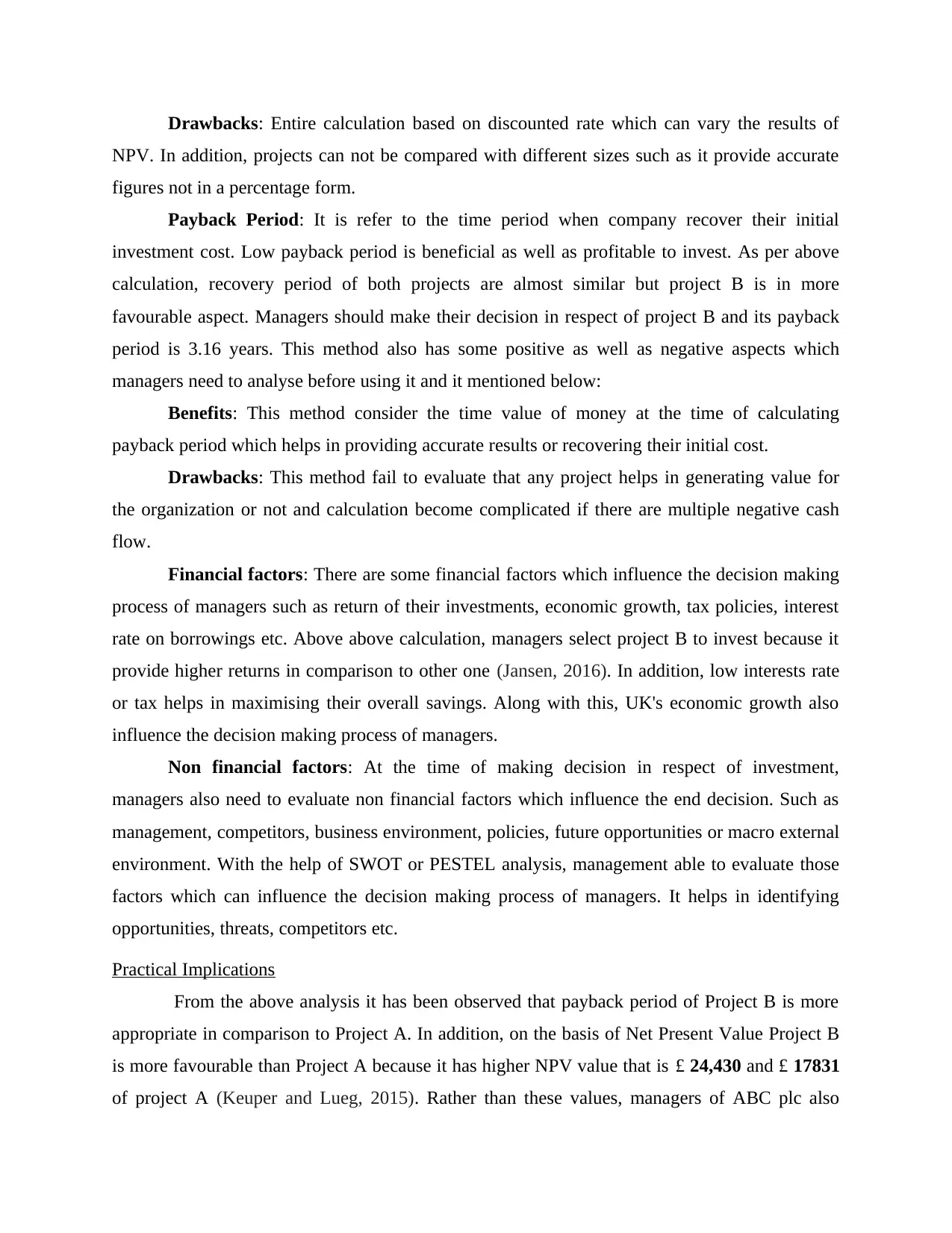
Drawbacks: Entire calculation based on discounted rate which can vary the results of
NPV. In addition, projects can not be compared with different sizes such as it provide accurate
figures not in a percentage form.
Payback Period: It is refer to the time period when company recover their initial
investment cost. Low payback period is beneficial as well as profitable to invest. As per above
calculation, recovery period of both projects are almost similar but project B is in more
favourable aspect. Managers should make their decision in respect of project B and its payback
period is 3.16 years. This method also has some positive as well as negative aspects which
managers need to analyse before using it and it mentioned below:
Benefits: This method consider the time value of money at the time of calculating
payback period which helps in providing accurate results or recovering their initial cost.
Drawbacks: This method fail to evaluate that any project helps in generating value for
the organization or not and calculation become complicated if there are multiple negative cash
flow.
Financial factors: There are some financial factors which influence the decision making
process of managers such as return of their investments, economic growth, tax policies, interest
rate on borrowings etc. Above above calculation, managers select project B to invest because it
provide higher returns in comparison to other one (Jansen, 2016). In addition, low interests rate
or tax helps in maximising their overall savings. Along with this, UK's economic growth also
influence the decision making process of managers.
Non financial factors: At the time of making decision in respect of investment,
managers also need to evaluate non financial factors which influence the end decision. Such as
management, competitors, business environment, policies, future opportunities or macro external
environment. With the help of SWOT or PESTEL analysis, management able to evaluate those
factors which can influence the decision making process of managers. It helps in identifying
opportunities, threats, competitors etc.
Practical Implications
From the above analysis it has been observed that payback period of Project B is more
appropriate in comparison to Project A. In addition, on the basis of Net Present Value Project B
is more favourable than Project A because it has higher NPV value that is £ 24,430 and £ 17831
of project A (Keuper and Lueg, 2015). Rather than these values, managers of ABC plc also
NPV. In addition, projects can not be compared with different sizes such as it provide accurate
figures not in a percentage form.
Payback Period: It is refer to the time period when company recover their initial
investment cost. Low payback period is beneficial as well as profitable to invest. As per above
calculation, recovery period of both projects are almost similar but project B is in more
favourable aspect. Managers should make their decision in respect of project B and its payback
period is 3.16 years. This method also has some positive as well as negative aspects which
managers need to analyse before using it and it mentioned below:
Benefits: This method consider the time value of money at the time of calculating
payback period which helps in providing accurate results or recovering their initial cost.
Drawbacks: This method fail to evaluate that any project helps in generating value for
the organization or not and calculation become complicated if there are multiple negative cash
flow.
Financial factors: There are some financial factors which influence the decision making
process of managers such as return of their investments, economic growth, tax policies, interest
rate on borrowings etc. Above above calculation, managers select project B to invest because it
provide higher returns in comparison to other one (Jansen, 2016). In addition, low interests rate
or tax helps in maximising their overall savings. Along with this, UK's economic growth also
influence the decision making process of managers.
Non financial factors: At the time of making decision in respect of investment,
managers also need to evaluate non financial factors which influence the end decision. Such as
management, competitors, business environment, policies, future opportunities or macro external
environment. With the help of SWOT or PESTEL analysis, management able to evaluate those
factors which can influence the decision making process of managers. It helps in identifying
opportunities, threats, competitors etc.
Practical Implications
From the above analysis it has been observed that payback period of Project B is more
appropriate in comparison to Project A. In addition, on the basis of Net Present Value Project B
is more favourable than Project A because it has higher NPV value that is £ 24,430 and £ 17831
of project A (Keuper and Lueg, 2015). Rather than these values, managers of ABC plc also
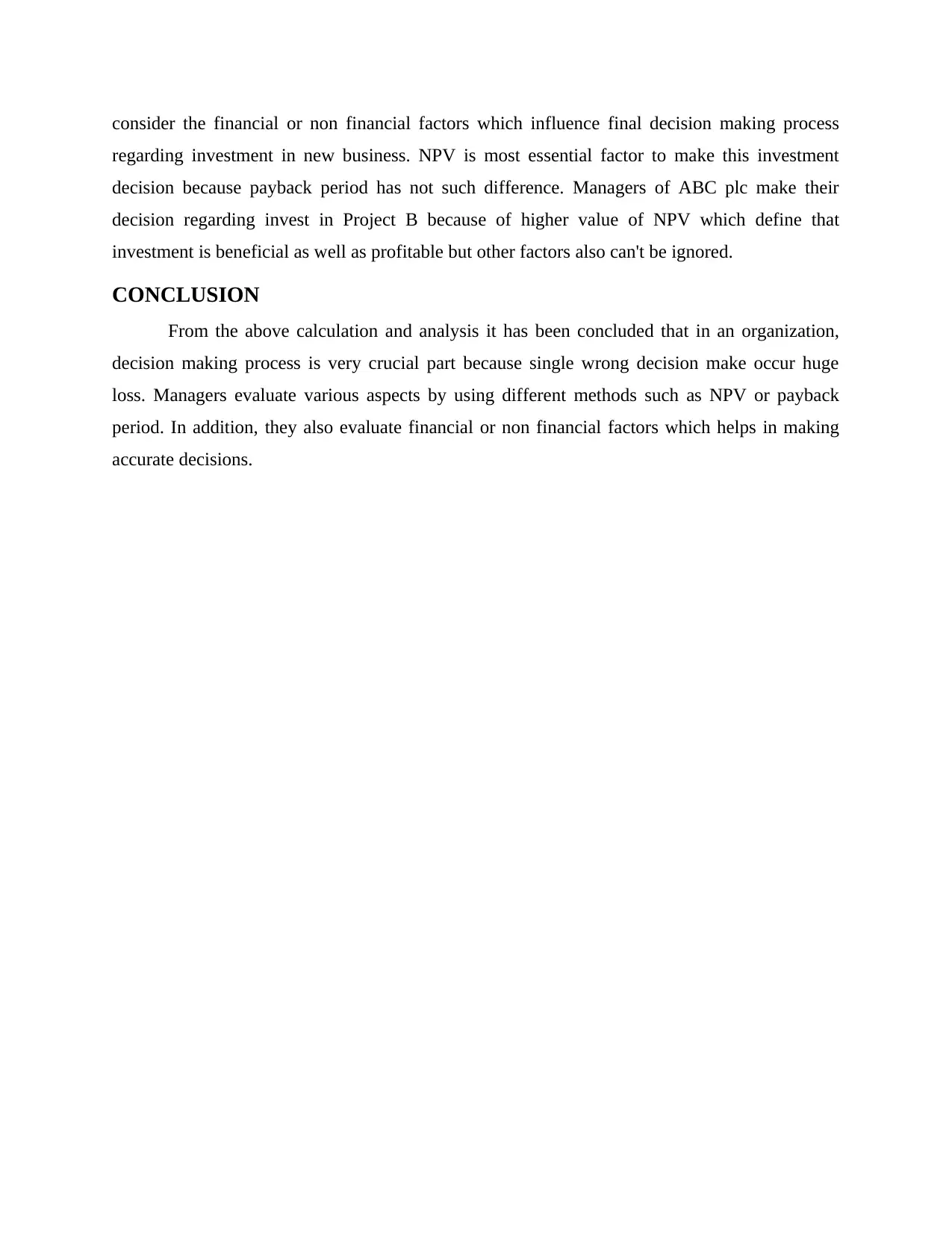
consider the financial or non financial factors which influence final decision making process
regarding investment in new business. NPV is most essential factor to make this investment
decision because payback period has not such difference. Managers of ABC plc make their
decision regarding invest in Project B because of higher value of NPV which define that
investment is beneficial as well as profitable but other factors also can't be ignored.
CONCLUSION
From the above calculation and analysis it has been concluded that in an organization,
decision making process is very crucial part because single wrong decision make occur huge
loss. Managers evaluate various aspects by using different methods such as NPV or payback
period. In addition, they also evaluate financial or non financial factors which helps in making
accurate decisions.
regarding investment in new business. NPV is most essential factor to make this investment
decision because payback period has not such difference. Managers of ABC plc make their
decision regarding invest in Project B because of higher value of NPV which define that
investment is beneficial as well as profitable but other factors also can't be ignored.
CONCLUSION
From the above calculation and analysis it has been concluded that in an organization,
decision making process is very crucial part because single wrong decision make occur huge
loss. Managers evaluate various aspects by using different methods such as NPV or payback
period. In addition, they also evaluate financial or non financial factors which helps in making
accurate decisions.
⊘ This is a preview!⊘
Do you want full access?
Subscribe today to unlock all pages.

Trusted by 1+ million students worldwide
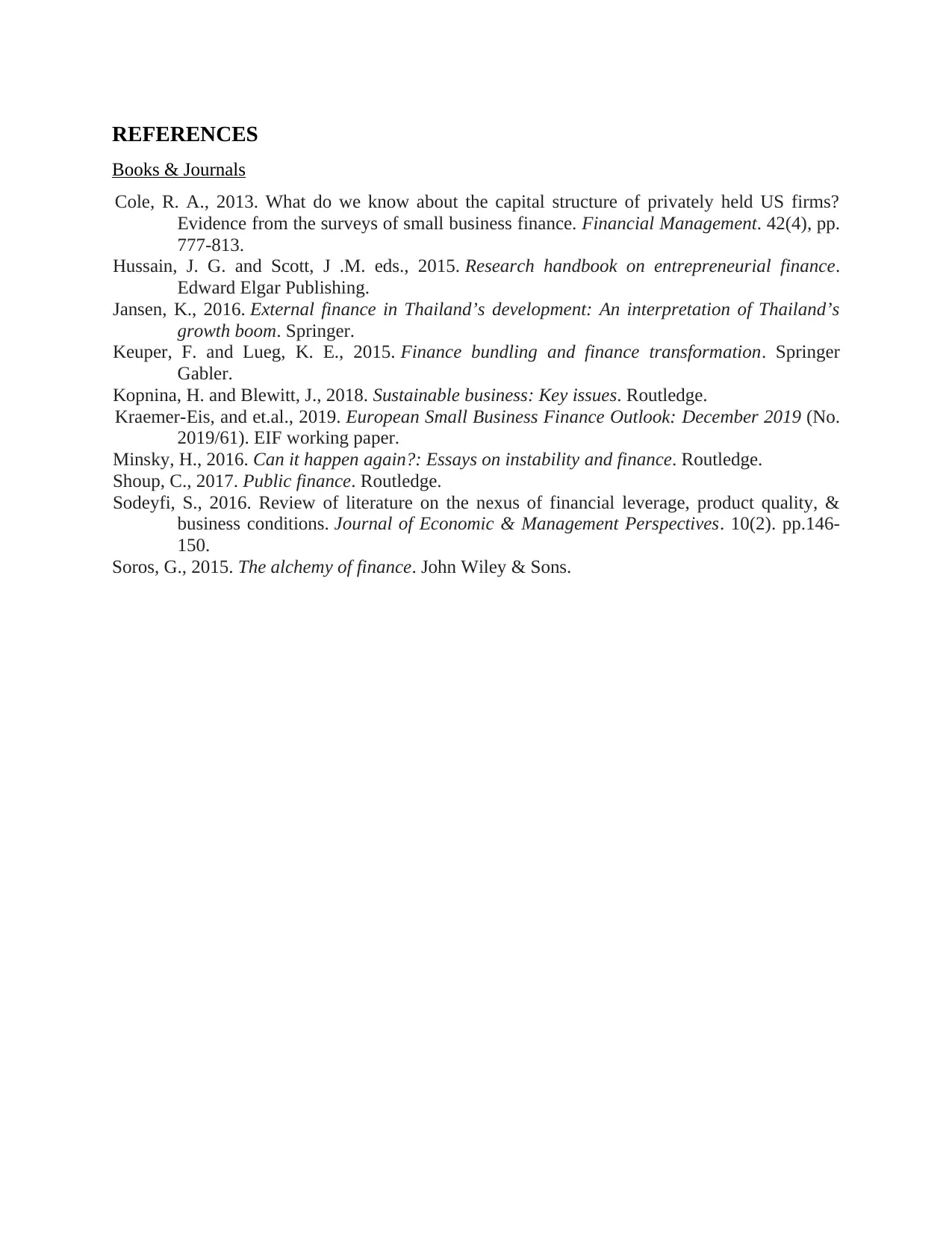
REFERENCES
Books & Journals
Cole, R. A., 2013. What do we know about the capital structure of privately held US firms?
Evidence from the surveys of small business finance. Financial Management. 42(4), pp.
777-813.
Hussain, J. G. and Scott, J .M. eds., 2015. Research handbook on entrepreneurial finance.
Edward Elgar Publishing.
Jansen, K., 2016. External finance in Thailand’s development: An interpretation of Thailand’s
growth boom. Springer.
Keuper, F. and Lueg, K. E., 2015. Finance bundling and finance transformation. Springer
Gabler.
Kopnina, H. and Blewitt, J., 2018. Sustainable business: Key issues. Routledge.
Kraemer-Eis, and et.al., 2019. European Small Business Finance Outlook: December 2019 (No.
2019/61). EIF working paper.
Minsky, H., 2016. Can it happen again?: Essays on instability and finance. Routledge.
Shoup, C., 2017. Public finance. Routledge.
Sodeyfi, S., 2016. Review of literature on the nexus of financial leverage, product quality, &
business conditions. Journal of Economic & Management Perspectives. 10(2). pp.146-
150.
Soros, G., 2015. The alchemy of finance. John Wiley & Sons.
Books & Journals
Cole, R. A., 2013. What do we know about the capital structure of privately held US firms?
Evidence from the surveys of small business finance. Financial Management. 42(4), pp.
777-813.
Hussain, J. G. and Scott, J .M. eds., 2015. Research handbook on entrepreneurial finance.
Edward Elgar Publishing.
Jansen, K., 2016. External finance in Thailand’s development: An interpretation of Thailand’s
growth boom. Springer.
Keuper, F. and Lueg, K. E., 2015. Finance bundling and finance transformation. Springer
Gabler.
Kopnina, H. and Blewitt, J., 2018. Sustainable business: Key issues. Routledge.
Kraemer-Eis, and et.al., 2019. European Small Business Finance Outlook: December 2019 (No.
2019/61). EIF working paper.
Minsky, H., 2016. Can it happen again?: Essays on instability and finance. Routledge.
Shoup, C., 2017. Public finance. Routledge.
Sodeyfi, S., 2016. Review of literature on the nexus of financial leverage, product quality, &
business conditions. Journal of Economic & Management Perspectives. 10(2). pp.146-
150.
Soros, G., 2015. The alchemy of finance. John Wiley & Sons.
1 out of 7
Related Documents
Your All-in-One AI-Powered Toolkit for Academic Success.
+13062052269
info@desklib.com
Available 24*7 on WhatsApp / Email
![[object Object]](/_next/static/media/star-bottom.7253800d.svg)
Unlock your academic potential
Copyright © 2020–2025 A2Z Services. All Rights Reserved. Developed and managed by ZUCOL.





